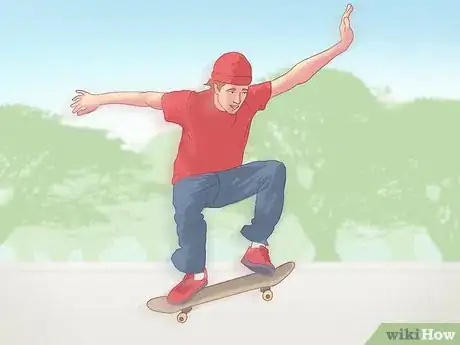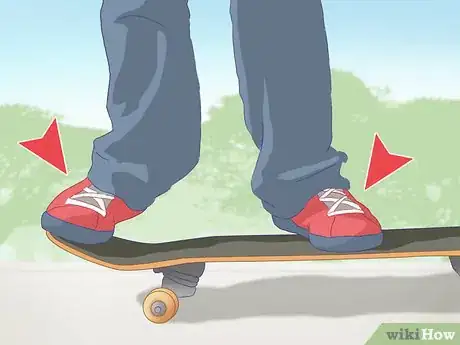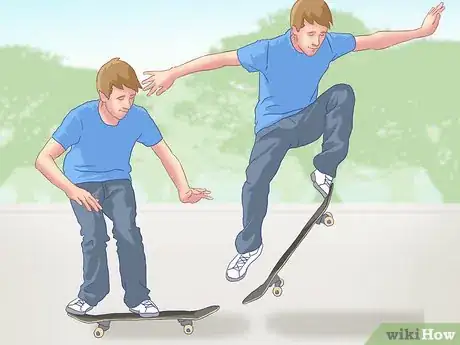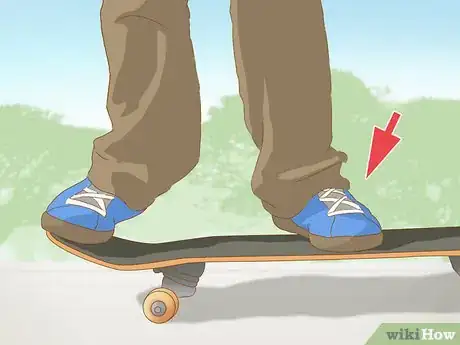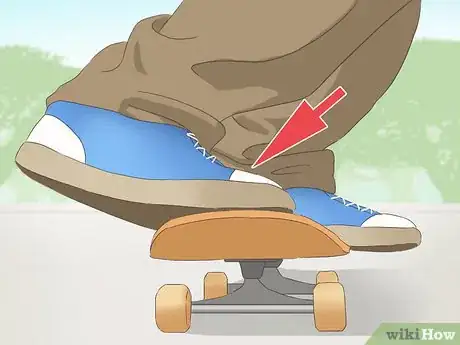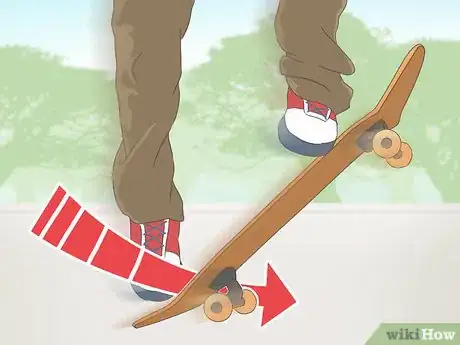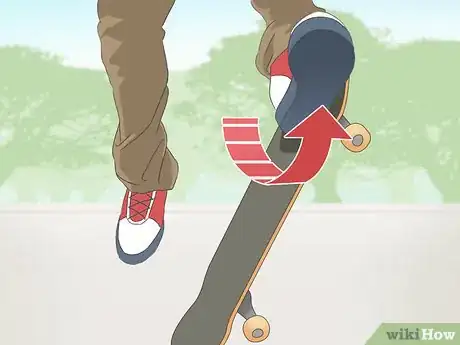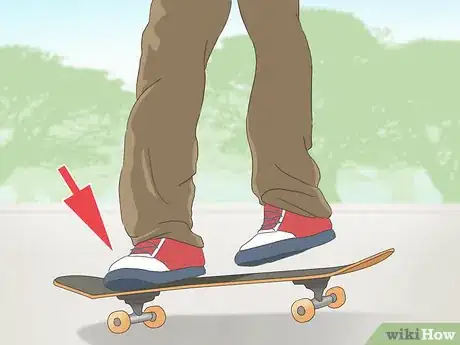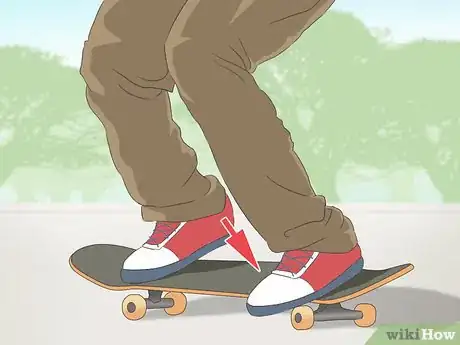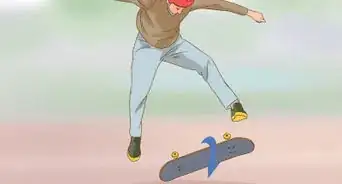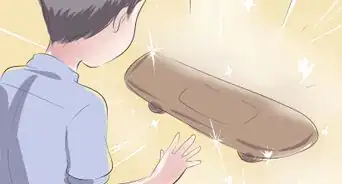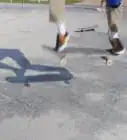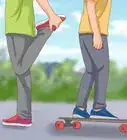X
wikiHow is a “wiki,” similar to Wikipedia, which means that many of our articles are co-written by multiple authors. To create this article, 35 people, some anonymous, worked to edit and improve it over time.
This article has been viewed 53,939 times.
Learn more...
An inward heelflip is essentially the combination of a pop shove-it and a heelflip. The trick is performed by popping your board up in an ollie like maneuver, then flipping the board with your front heel while scooping the tail of the board to cause it to rotate. The inward heelflip is an advanced trick that may take a lot of practice. Before attempting the inward heelflip, be comfortable with both the heelflip and the pop shove-it.
Steps
Part 1
Part 1 of 3:
Performing an Ollie
-
1Start with an ollie. Being able to perform an ollie is probably the first trick any skateboarder learns. An ollie serves as the base for most skateboard tricks, like an inward heelflip. Before attempting an inward heelflip, get comfortable performing an ollie, heelflip, and a pop shove-it.
- An ollie is when you kick your board up into the air and then land back on the ground.
- A heelflip is when you use your front heel to flip your board 360-degrees in a counterclockwise rotation.
- A pop shove-it is when you perform an ollie while scooping the tail of your board causing your board to rotate 180 degrees.
- In order to perform even a heelflip, you will have to start out as if you are doing an ollie. Then while you’re in the air, you will rotate your board toward with your heel.
-
2Place your feet for an ollie. Place your leading foot near the middle of your board. Place your back foot on the tail of your board.
- Your front foot should be wholly on your board for an ollie. Your back foot should be hanging off the board a bit. You want the ball of your foot to be planted on the board with your heel over the edge.
- Make sure you feel comfortable with the placement of your feet. Where exactly you place your feet will be up to you and what feels the most natural.
- In skateboarding there are two types of stances, Goofy stance is when you face your body left in the direction of travel. Your right foot is in front. Regular stance is when you face right in the direction of travel. Your left foot is in front.
Advertisement -
3Bend your knees. When you crouch to do an ollie you want to bend at your knees so your body stays balanced. Put your weight on the balls of both feet.
- To perform an ollie, you need to use your feet and legs to kick the board up into the air. Properly bending your knees will give you leverage.
- Keep your shoulders squared and level with your feet.
- Pop up into an ollie. Snap the tail of your board down onto the ground with your back foot. Simultaneously, slide your front foot forward up the length of the deck toward the nose. As you make these moves, you want to use the momentum to jump up in the air.
- Your front foot lifts the board off the ground and also levels out the board in the air.
- Slide your front foot with the outer edge of your foot, not the bottom of it.
- Once you get the hang of performing an ollie, practice doing an ollie while moving. Having more forward momentum may make landing an inward heelflip easier.
- Next, move on to incorporating the pop shove-it. Instead of snapping down with your back foot, you want to scoop it backward.
Advertisement
Part 2
Part 2 of 3:
Positioning Your Feet for an Inward Heelflip
-
1Start by setting your feet again for an ollie. An inward heelflip is essentially a pop shove-it with an extra step to the trick. Begin by setting your feet as if you are going to perform an ollie or pop shove-it.
- Place your front foot toward the middle of the board and your back foot on the tail. [1]
-
2Adjust your front foot. Unlike a regular ollie, the heelflip, and inward heelflip requires you to do a little more work with your front foot. You’ll need to flip your board with the heel of your front foot, so you want to position it more forward.
- Place your front foot so that the toes of your foot are hanging over the front edge of your board.
- You may also want to play with how far forward your front foot is. For the heelflip portion of the trick, you’ll be kicking your foot up and out at the same time. Try placing your front foot closer to the nose of your deck.
- Don’t place your front foot too far forward otherwise you won’t get enough leverage. Try placing your foot just behind the bottom front bolts.
- You can rotate your front foot to about a 45-degree angle. The angle will help you flick your foot and spin the board.
-
3Adjust your back foot. For an inward heelflip, your back foot is also going to be doing a little more than it would for an ollie or regular heelflip. Place your back foot closer to the tip of the tail for a heelflip. Placing your back foot higher up on the tail will help you get more pop and allow you to jump higher, getting your foot out of the way while the board flips.
- Play around adjusting your back foot closer to the opposite edge of the board that your front foot is on. Though you need your board to flip in a forward motion, going counterclockwise, moving your back foot to the back edge will help you with balance and with getting the pop shove-it rotation.
- When you perform the trick, you’ll need to scoop the tail of the board back a little. While you pull back slightly with your back foot to scoop the board, your front foot will be flicking the opposite edge to create the flip.
-
4Test your balance. With your feet positioned for a heelflip, get used to how your body feels. Rock back and forth and bend your knees.
- Get used to how you feel with your feet in this new position. Practice sliding your front forward and flicking the edge of your board with your heel. Remember to keep your body centered.
Advertisement
Part 3
Part 3 of 3:
Performing an Inward Heelflip
-
1Pop your tail down and scoop. Begin your inward heelflip by popping the back of your board down like you would an ollie. Then as the board begins to rise from the action in your front foot, scoop the tail back a little to start the inward rotation. [2]
- The inward heelflip begins pretty much the same way as an ollie does. The difference is that your back foot is more on the edge of your board’s tail. And instead of keeping the board connected to your back foot, like you might with an ollie, you’re kicking that back foot up and higher in a scooping motion to give the board room to rotate.
-
2Slide your front foot up and out. Slide your front foot up toward the nose of your board like you would with an ollie. Then, instead of moving your foot toward the center of the nose, kick it forward and out in front of you. [3]
- The trick here is to flip your board by hitting the front edge with your heel. Your front foot should kick out almost as if you were to do a forward karate kick.
- Keep the toes of your front foot pointed up. As you kick out, you’re trying to smack the edge of the board with your heel as you bring your foot up and in front of you. Aim to catch the board on your heel where the slope of the nose begins. By hitting the front of the board down where the nose begins to slope on the outer edge, and scooping the tail up you’re creating the inward momentum that will cause the board to flip and rotate.
- Though your heel is hitting the edge of the board and causing it to flip in a downward motion, you want to be moving your feet in an upward motion. Don’t think of it like you're stomping the edge of the board down. Imagine your foot moving out and up, meeting the edge of the board as it moves forward.
-
3Catch the board with your back foot. After your board spins and rotates, you want to catch the tail with your back foot to help bring the board level. [4]
- Your back foot is used to stabilize your board in the air. Catching the board with your back foot will help you to keep the board from spinning any further, allowing you to land safely.
-
4Bring your front foot to the board and land. Though it will take practice, the idea here is to let the front of the board come up to meet your front foot. Once you feel it under you, bring your legs down to land.
- Both your front and back feet will hit the board at nearly the same time, but it helps to visualize using your back foot as an anchor or stabilizer and your front foot as the downward force.
- During your inward heelflip your feet should never be below your board.
Advertisement
Warnings
- If you feel the board not flipping and and rotating enough, it’s ok to bail and get out of the way. Don’t try to land the trick if you haven’t flipped it properly.⧼thumbs_response⧽
- Always wear protective gear. Skateboarding is dangerous and should be exercised with extreme caution.⧼thumbs_response⧽
Advertisement
References
About This Article
Advertisement
